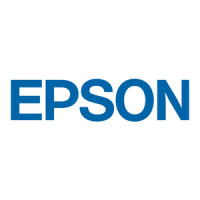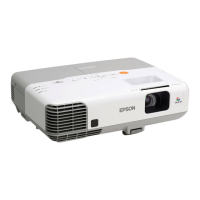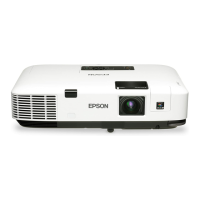Quick Setup
Before using the projector, make sure you read the safety instructions in the
online User’s Guide.
Connect the projector
Choose from the following connections. See the sections below or the online
User's Guide for details.
Computer
VGA cable
USB cable
HDMI cable
USB Port
Connect the square end of a USB cable to the projector’s USB TypeB
(square) port. Connect the flat end of the cable to any USB port on your
computer.
Windows
®
2000 SP4 or later: After turning on the projector, follow
the on-screen instructions to install the Epson USB Display software
(EMP_UDSE.EXE; only on first connection).
Note: If the software screen does not display automatically, open My
Computer or Computer, then double-click EPSON_PJ_UD.
Mac OS
®
X 10.5.1 or higher: After turning on the projector, the setup folder
for USB Display appears in the Finder. Double-click USB Display Installer and
follow the on-screen instructions to install the Epson USB Display software
(only on first connection).
Monitor Port
Connect one end of a VGA cable to the projector’s Computer1 or
Computer2 port, and the other end to your computer’s monitor port. If
you are using a laptop, switch it to external display (see “Troubleshooting”).
You can also connect an audio cable.
HDMI Port
Connect one end of an HDMI cable to the projector’s HDMI port and the other
end to an HDMI port on your computer.
Wired Network
You can connect the projector to your network using an Ethernet
®
cable.
See “Project over a wired network” for instructions.
Video Device
Connect up to 5 video devices and use the Source Search button on the
projector or remote control to switch between them.
RCA video cable (composite video)
Component video to VGA cable
Audio cable
S-Video cable
Audio cable
HDMI cable
Camera, USB Device, or Epson Document Camera DC-06
Connect a digital camera, USB flash drive, USB storage device, or Epson
document camera DC-06 to the projector’s USB TypeA (flat) port.
If you connect a digital camera, USB flash drive, or USB storage device, you can
use the projector’s Slideshow feature to project images. See the online User’s
Guide for details.
External Monitor and External Speakers
You can also connect an external monitor and external speakers to your
projector to enhance your presentations. See the online User’s Guide for details.
Turn on your equipment
1
Turn on your computer or video source.
2
Plug in the projector. The power light on the projector turns orange.
3
Open the A/V Mute slide all the way.
4
Press the power button on the projector or remote control. The
projector beeps, the power light flashes green, and then stays on.
Note: To shut down the projector, press the power button twice, then
unplug it. You don’t have to wait for the projector to cool down.
5
The default language of the menu system is English. To select another
language, press the Menu button on the remote control. Select
Extended and press Enter. Select Language and press Enter. Select
your language and press Enter. Press the Menu button to exit the
menu system.
Adjust the image
1
If you don’t see an image, press the Source Search button on the
projector or the remote control to select the image source.
Note: If you still see a blank screen or have other display problems, see
the troubleshooting tips on the back of this sheet.
2
To raise the image, press the foot release button and lift the front of the
projector. Release the button to lock the foot in position.
3
Turn the zoom ring to reduce or enlarge the image.
4
Turn the focus ring to sharpen the image.
5
If your image looks like or , you’ve placed the projector off
to one side of the screen at an angle. Use the horizontal slider on the
projector to correct it. Or place the projector directly in front of the
center of the screen, facing the screen squarely.
6
Your projector automatically adjusts images that look like or ,
but if necessary you can press the or buttons on the projector to
correct it.
Using the remote control
Make sure the batteries are installed as shown (two AA batteries).
Choose which
source to display
Turn projector
on and off
Access projector
menus
Turn off projector
display
Get solutions to
common problems
Navigate projector
menus
For more information on using the remote control, see the online User’s
Guide.
Project over a wired
network
Follow the steps here to configure your projector for your wired network
using the projector’s menu system.
1
Plug in and turn on the projector.
2
Press the Menu button on the remote control, select the Network
menu, and press Enter.
3
Select Network Configuration and press Enter.
4
Select the Basic menu and press Enter.
PowerLite
®
1880












